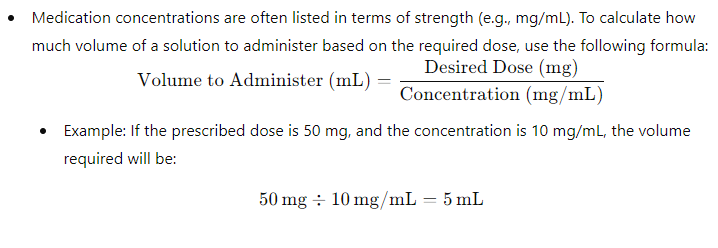Dosage Calculations and Safe Administration Practices
Dosage Calculations and Safe Administration Practices in PediatricsPediatric dosage calculations and safe administration practices are essential to ensure that medications are administered correctly, efficiently, and safely. Since children have distinct physiological characteristics compared to adults, their medication requirements differ significantly. These differences include variations in their body size, organ function, and developmental stages, which can impact how drugs are absorbed, distributed, metabolized, and eliminated.
This guide provides an overview of key principles and best practices for pediatric dosage calculations and medication administration.
1. Principles of Pediatric Dosage CalculationsDosage calculations in pediatrics are based on several critical factors, including the child’s age, weight, and the specific drug being administered. The goal is to ensure that the dose is both effective and safe for the child’s developmental stage and medical condition.
Factors Affecting Pediatric Dosage Calculations
Weight-based Dosing: In most pediatric cases, medication doses are calculated based on the child's weight in kilograms (kg). For example, a common formula for dosing is mg/kg.
Age-based Dosing: In some instances, medications are dosed based on age ranges (e.g., infants, toddlers, children, adolescents) when weight information is unavailable.
Body Surface Area (BSA): For certain drugs, particularly chemotherapy agents or those used in intensive care, dosing may be calculated based on body surface area (BSA), which is a more precise way to estimate the metabolic mass of the child.
Common Formulas Used for Dosage Calculations

After calculating BSA, this figure is used to adjust dosages for medications that require BSA-based dosing.
Concentration Calculations:

2. Steps in Safe Pediatric Medication AdministrationEnsuring safe and accurate medication administration requires meticulous attention to detail. Below are the key steps in safe pediatric medication administration.
Step 1: Verify the Prescription
Before administering any medication, it is essential to verify the medication order. This includes:
Medication name: Ensure the correct drug is prescribed.
Dosage: Verify the prescribed dose is appropriate for the child's weight and age.
Route of administration: Check the specified route (oral, IV, intramuscular, etc.).
Time of administration: Ensure the correct timing (e.g., before or after meals, once daily).
Duration of treatment: Ensure the duration aligns with the treatment plan.
Step 2: Prepare the Medication
Use age-appropriate medications and formulations (liquid, chewable tablets, etc.).
If the medication requires preparation (e.g., mixing powder into a solution), follow the correct instructions.
Double-check concentrations and dilution instructions.
Use correct measuring tools (e.g., oral syringes, measuring spoons, etc.) to ensure accurate dosing.
Step 3: Calculate the Correct Dose
Based on the child's weight, age, and the prescribed dosage guidelines, calculate the exact medication dosage. Always use weight-based dosing, when possible, as this helps minimize errors.
Step 4: Double-Check the Calculations
Verify calculations independently. If you're unsure of the calculations, consult with a colleague or a pharmacist to double-check.
Use a second method (if available) to ensure the dose is correct, such as using a dosing chart or calculator.
Verify that the correct volume is prepared, especially when dealing with liquid medications.
Step 5: Administer the Medication
Route: Administer the medication via the prescribed route (oral, intravenous, intramuscular, etc.).
Monitoring: Pay attention to the child’s comfort during administration. For oral medications, encourage the child to swallow the medication without force.
Documentation: Record the dose, time of administration, and any relevant observations (e.g., reactions, side effects).
Step 6: Observe and Monitor for Adverse Effects
Monitor for side effects: Observe the child for any potential side effects (e.g., allergic reactions, gastrointestinal upset, drowsiness).
Ensure effectiveness: Reassess the child’s condition and report if the medication seems ineffective or if side effects appear.
Report unusual events: Immediately report any unexpected side effects or adverse events to the healthcare team.
3. Strategies to Minimize Medication Errors in PediatricsGiven the complexities and potential for error, it’s crucial to implement strategies to reduce the risk of medication mistakes.
1. Use the "Five Rights" of Medication Administration
Right patient: Confirm the identity of the child using two identifiers (e.g., name, date of birth).
Right medication: Ensure that the prescribed medication is the one you administer.
Right dose: Double-check the dosage, ensuring it is appropriate for the child's weight or age.
Right route: Ensure the medication is administered via the prescribed route (oral, IV, etc.).
Right time: Administer the medication at the prescribed time.
2. Minimize the Use of Abbreviations
Avoid using ambiguous abbreviations or shorthand that may cause confusion. Always use the full name of medications, doses, and routes.
3. Keep Medications in Original Packaging
Store medications in their original packaging to avoid errors. This helps identify the medication and ensures the correct labeling, including expiration dates.
4. Parental Education
Provide parents and caregivers with clear, written instructions for home administration, including:
Correct dosage and timing
Method of administration
Potential side effects
How to handle missed doses or overdose
Proper storage
5. Collaboration and Consultation
Consult with pharmacists: When in doubt about drug interactions, side effects, or formulations, consult with a pharmacist.
Involve the healthcare team: When there are concerns about prescribing or administering medication, consult with doctors, nurses, or specialists.